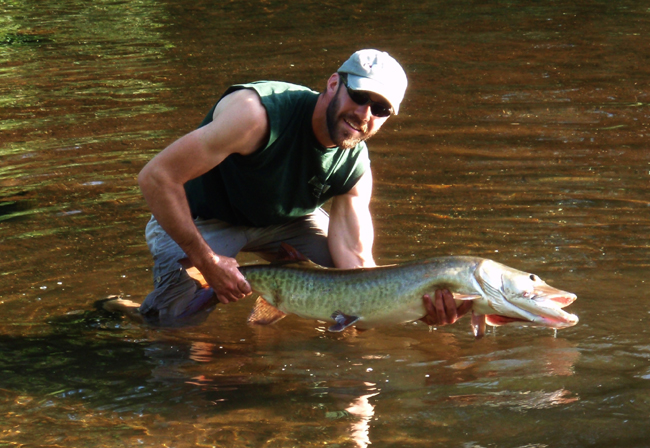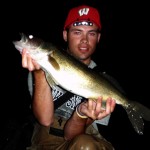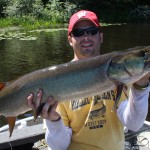By: Adam Glickman – Date Posted: May 11, 2012
I stood knee deep in the small river with its root beer colored water rolling around my legs. My casting target was the eddy behind a large boulder. The current all around was swift, so I lead my mark upstream and cast beyond the boulder. I kept my rod tip up to keep my line from dragging in the rushing water and began my cadence. The topwater plug came to life and slid smoothly back and forth across the surface. I adjusted the speed of the lure so its angled path would run directly into the sheltered water created by the large current obstruction. As the lure hit the current seam of the eddy, the water’s directional changed caused a stutter in its rhythmic motion, but as soon as it recovered a nice musky swung on the plug with perfect timing. The lure was T-boned in its jaws, and a firm hookset kept it from making the complete whirl it would have normally used to achieve proper predatory speed in the confines of the eddy. After a brief but spectacular battle in the shallow fast water, the musky’s lower jaw made it into my boga grip.
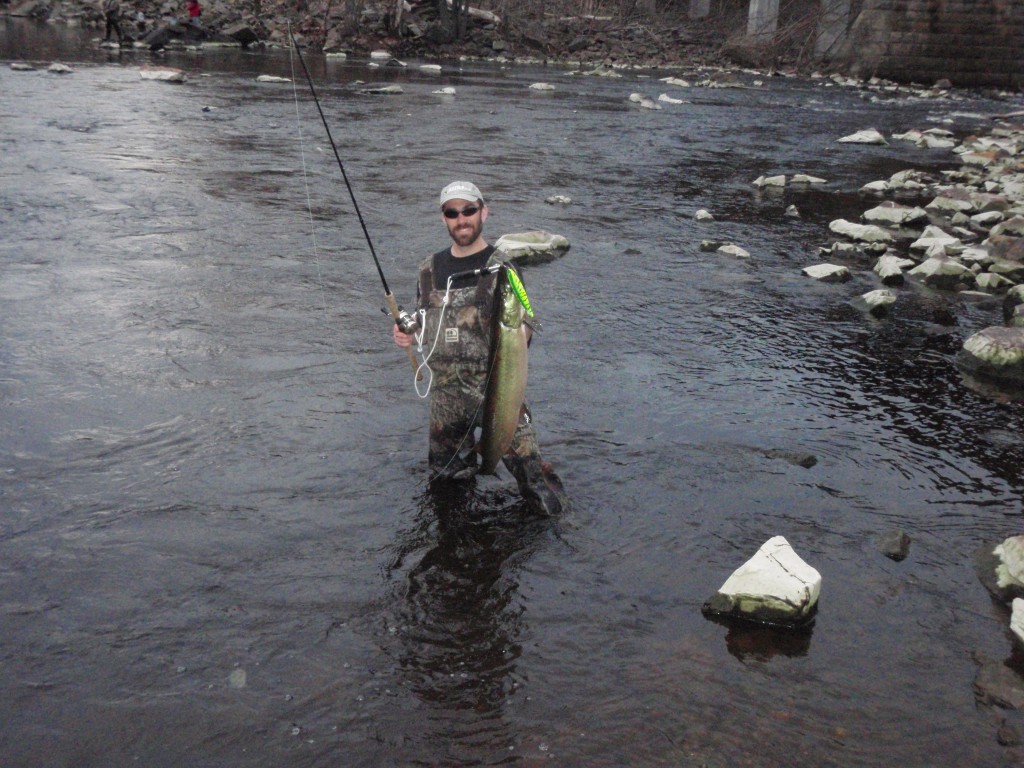
I fish small rivers and streams for muskies year round, but I concentrate on them very heavily in May and June because their fish are often very concentrated in certain areas and they are also less impacted by tough weather conditions common to the early part of the season. The action can be excellent, but effective tactics are very specialized. Those wanting to try this must take certain factors into consideration. Choosing the right river to fish is very important. Properly accessing and navigating the chosen river is very important for success and safety. Techniques must be tailored to properly present lures to a moving, often shallow, and usually obstruction filled environment. Also, certain tools and methods will be needed to effectively and safely land, handle, and release muskies at close quarters.
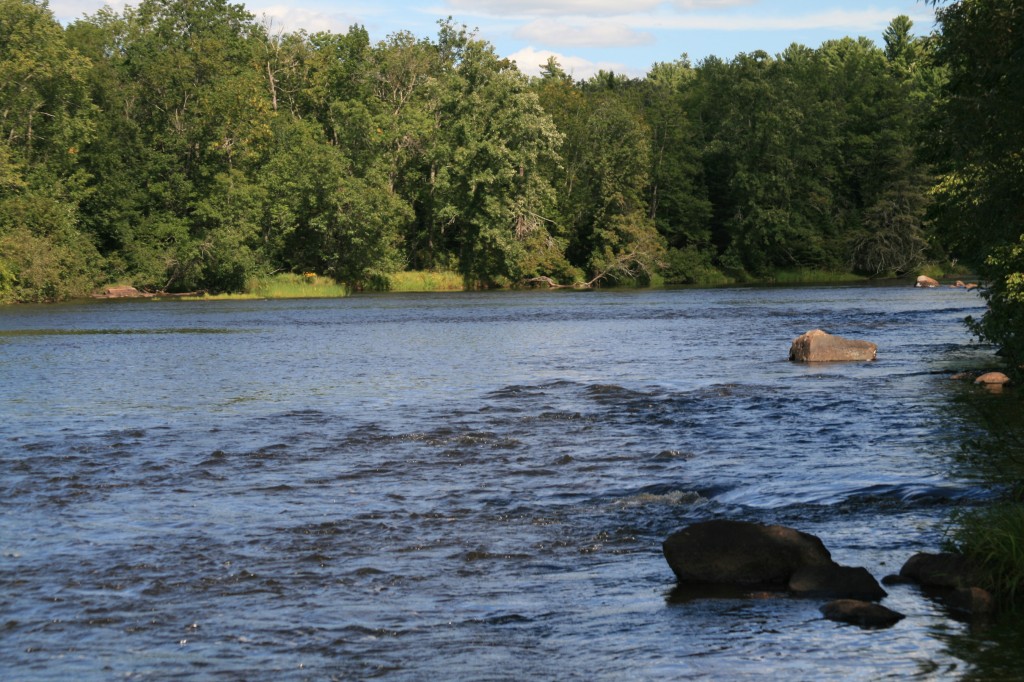
Choosing Water
Excellent musky streams exist all through the Midwest, out to the east coast, and as far into the south as Tennessee and North Carolina. Historically, Wisconsin contained the most natural musky waters in the muskies’ original home range. The watersheds of the northern tier of Wisconsin are a maze of branching main rivers and tributaries that are still filled with muskies today. Nearly all warm water streams and rivers of the region have fishable populations of muskies. Some stretches of these rivers are very large, others are often less than 10 yards across, while the rest run the gamut between the two extremes. Some of these rivers are well known musky producers and receive a decent amount of fishing pressure. Others have populations that are largely unknown and are little pressured by anglers. Finding such waters is as easy as looking at a map to find tributaries of larger well known musky rivers. The next step is driving to some of those tributaries for a visual inspection. If they look good (current, holes, structure, etc.) they probably are good, especially if they have a decent amount of water 3’ deep or deeper.
In early May, muskies are often using such tributaries for reproduction. After that, they remain to intercept their sucker forage base as they reproduce immediately after. White and redhorse suckers usually spawn just days after muskies, and have already entered such areas. Muskies will also use the same tributaries to escape turbulence during periods of high water throughout the season. The key is to never underestimate the muskies’ ability to move into small water. It is amazing to see how large fish use such tiny water, and watching them acquire a large lure on a short cast in a little area is nothing short of phenomenal. I also never overlook small tail waters below dams on known musky lakes and reservoirs. Early in the season, muskies that have wound up in these systems are often stacked up below such obstructions.
Through stocking efforts, the muskies’ home range has spread like wildfire over the past 20 years. Some rivers have been stocked intentionally while others have been established incidentally. Outside of the glacial regions of Wisconsin and Minnesota, there are fewer natural lakes but many reservoirs of all sizes that have been stocked with muskies. Below their dams, almost inevitably, populations of muskies exist. As long as the streams are more than a trickle and have water flow all year, muskies can survive in them. Dams with open spillways allow the most muskies through and create more potential in the river below.
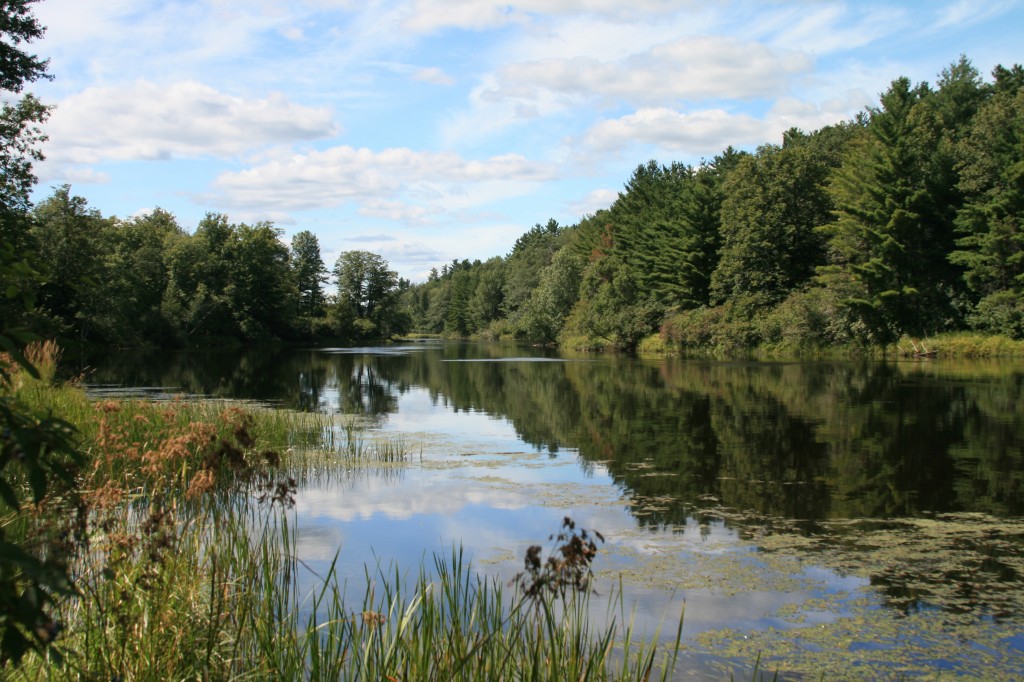
Tributaries of musky lakes and reservoirs also have great potential. They often hold fish early in the season. They also usually have better water quality if things heat up and the muskies need a more oxygenated refuge. The forage connection draws muskies into these areas as well. Muskies move in and out of these systems freely from the larger water body they flow into. Sometimes there may be none, but when conditions are right, it can be gang busters. Time on the water will help to predict feast or famine on individual waters.
I choose streams that best suit my needs. If I want to wade, walk the shores, and sneak up on muskies on foot; I choose smaller streams and rivers that are shallow enough for me to walk through. If I have to get out onto shore, the land around must be somewhat traversable. This means not all shear cliffs, swamps, or heavy underbrush. If the water gets too deep and I can’t get out on shore, it is time to turn back. Sometimes, back tracking and finding a land route around works, but it gets to be a lot of work and I have to closely examine if the juice is worth the squeeze. If I want to fish a river that I can’t walk I use a small jon boat. Canoes will work for those who don’t mind fishing from a seated position. Some of the new fishing kayaks are designed for anglers to stand in at times and are great for accessing tough to reach water.
Tennessee musky guide, Cory Allen, is a member of the Jackson Kayaks pro staff, and he fishes and guides muskies extensively from these versatile watercraft. Allen fishes regularly from his larger boat, a Tuffy Esox, but when he needs to find less pressured muskies in skinny hard to access rivers, his kayaks get the nod. Corey is also pioneering night fishing kayak tactics for muskies, which he says is a great summertime tactic and an ultimate rush. Once one becomes accustomed to the kayak, standing to fish in models specifically designed for fishing is not a problem. The Coosa and Big Tuna Kayaks from Jackson are specifically designed for the modern kayak angler. Allen prefers these models because they handle like a dream and turn on a dime.
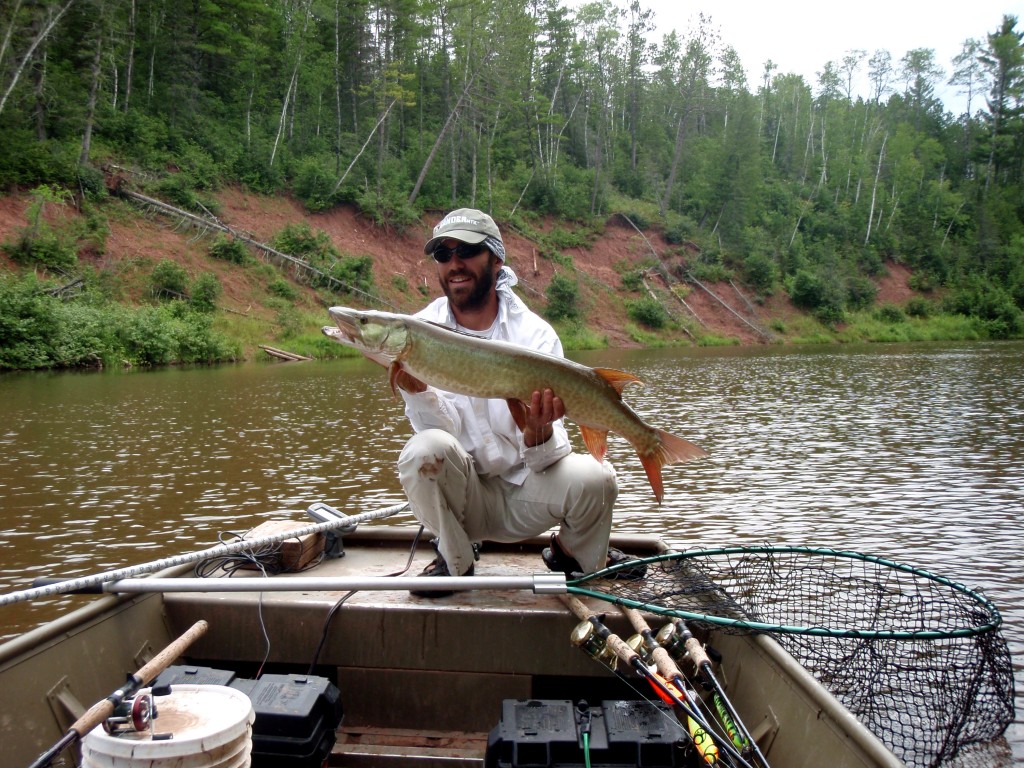
Access and Navigation
The main reason these streams have such good action is because there is little fishing pressure due to the fact that they are impossible to access with the large comfortable boats that most musky fishermen have grown accustomed to. Most anglers simply bypass such water, because they are too much work to fish. For those who don’t mind extra work and like to get up close and personal with the water, these streams are overlooked treasures.
Accessing small musky country rivers and streams can be tricky at best. The best ones rarely have paved ramps. Often, a roadside drag down or primitive landing is as good as it gets. A legitimate spot to park is also a very overlooked bonus. Often I find myself using the public right of way that exists on the land around road bridges. These areas usually have OK parking and there aren’t any trespassing issues. Bridges are great foot fishing accesses, but I also often find myself pulling and pushing small water craft up and down such embankments. It can be rough but often it pays off.
If I am covering long stretches of river, I usually fish with a friend and bring two vehicles. When in a boat, it is usually impossible to go back upstream, and when fishing on foot it gets too exhausting to walk back after covering miles of stream and rough terrain. Parking one vehicle at an insertion point and one at an extraction point is the way to go. If I am close to a town with a cab service and I know that I will have cell phone reception, I will often call for a ride back to my vehicle if I am alone or if it is less expensive to call a cab than to bring a second vehicle.
Once on the water, navigating streams and rivers takes special consideration whether on foot or in a boat. Currents are powerful even in small rivers and streams. If caution is not used, both water craft and anglers alike can get swept along and knocked against boulders and logs. As a rule, when wading, I don’t get in past my waist. When in my jon boat, I always carry a heavy river anchor. If things get going too fast and look like they are going to get too rough, I throw it out quick to stop (or at least slow down) and allow myself time to think of a solid game plan. In very shallow water, I often get out and walk my boat down stream. This slows it down, offers more control, and allows the boat to draft a little less water and clear more shallow obstructions.
If I am unsure if there are dangerous elevation changes (which cause rapids) in a particular stretch of river, I hike it and fish it on foot first for scouting purposes. The last thing I want is to be several miles down stream in my jon boat unable to safely proceed. Hauling everything back up stream or portaging such gear is arduous at best if not physically impossible. Of course, canoes and especially kayaks offer the option of handling rough water much more effectively and safely. They also portage with far greater ease if the terrain surrounding the area is conducive to a portage.
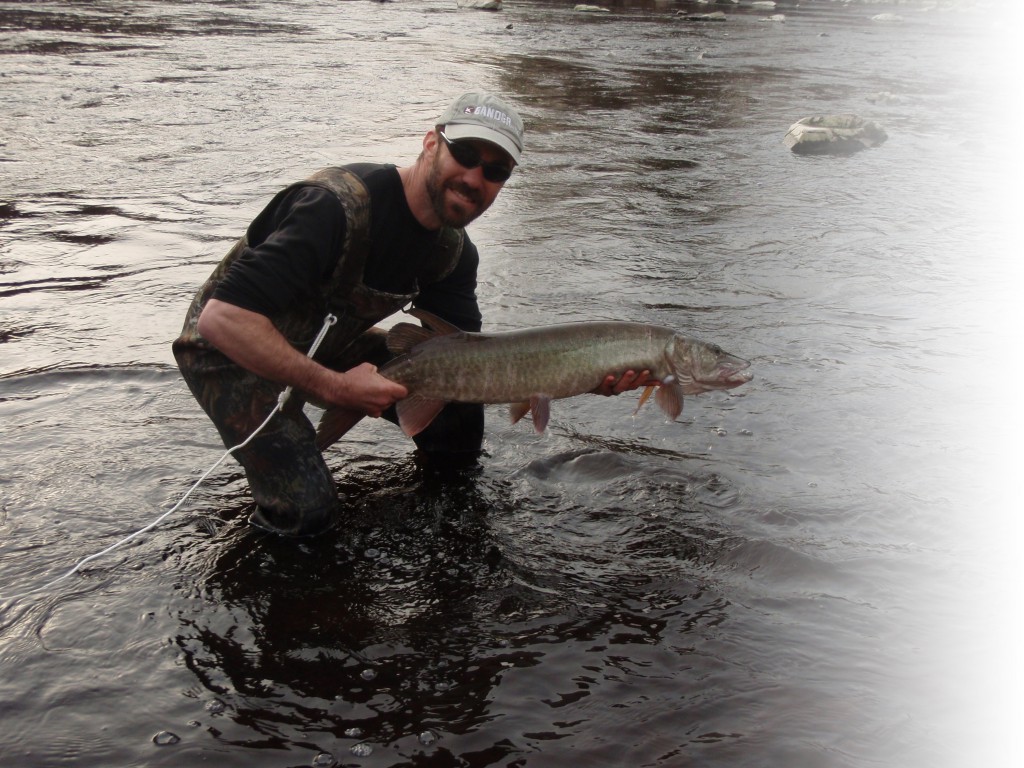
Presentation Consideration
A wide range of lures will work on small rivers and streams. In fact, all will have their time and place, but practicality plays a huge role. Some lures are just not practical when fishing heavy structure and shallow moving water at close quarters. Lures don’t have to be small by any means, but I try to keep my selections to a half pound or under. Considering the lures available to modern musky anglers, I am in no way being facetious when making such a statement. Anything over a half pound is almost always going to be a fast sinking lure which is counter productive in shallower water. Such lures will also enter the water with way too much noise, which is also unacceptable more often than not in small environments. Stealth plays a large role when fishing small rivers and streams, which is a huge reason fly anglers do so well when fishing muskies in such environments.
Large bass lures also work well for stream muskies. They enter the water quietly and often best match the available forage. At the top of my small lure list are Zara Spooks and #14 Husky Jerks, but bass sized spinner baits have an excellent profile, great sound signature, and work very well through heavy structure. Again, every individual environment will be different and experimentation is the best way to find the most successful pattern.
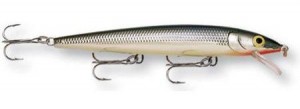
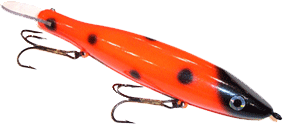
The water is small but the lures don’t have to be. Often, the muskies key in on larger standard size musky lures. Again, the key to success is letting the fish dictate what is best. Buoyant lures are much easier to use and snag much less, but sinking lures such as bucktails can be excellent and when used properly, snag very little as well. At the end of a cast using bucktails, the reel should be engaged and taking in line just before the lure hits the water to ensure that it stays just under the surface of the water at all times. Surface lures are usually the least problematic, are often extremely effective, and take some spectacular strikes. Buoyant lipped minnow baits are extremely versatile and effective. My personal favorites though are buoyant to neutrally buoyant jerkbaits, both gliders and divers. For me it almost always comes down to the choice of which jerkbait or surface lure I am going to use. These lures work the best for me and I enjoy fishing them. That does not mean that there aren’t other excellent options or that other anglers will experience the same results. I am a stead fast believer that certain lures just work better for certain anglers. I am not necessarily a religious man, but I do believe in faith. If one believes in something enough, often it will be so. In other words, confidence lures are key.
My favorite stream musky lures are Zara Spooks, #14 Husky Jerks, Bride of Creepensteines, Jackpots, Docs, Humpers, Whopper Ploppers, Top Raiders, Manta Hang 10’s, Bobbie Baits, and Magnum Shad Raps.
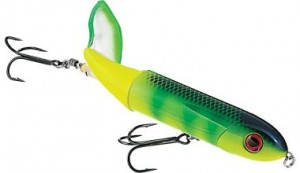
In small rivers, muskies often hold tight to cover, and therefore lures should be worked as close to cover as possible without snagging or breaking lures on rocks and wood. I like to use the current as much as possible. For instance, I will cast upstream and use the current to sweep my lure along through an eddy or along the edge of a fallen tree, log jam, or weed line. Contact with shallow obstructions is in inevitable, therefore diligent hook sharpening will result in more landed muskies.
I usually run my lures with the current, or across the current quartering upstream. However, I will often make casts down current and work my lure against or mostly against the current. Some people don’t like this, stating that it looks unnatural, but I counter such arguments by simply stating that all river fish swim up current as well. In my opinion, forage struggling against current looks like an easy meal. Lures that imitate this make a vulnerable and tempting target. Also, working against the current allows me to do cool things like swinging a Manta Hang 10 near a piece of structure for as long as I want. The end game of such a tactic is taunting a tough musky into coming out and taking a swing. It is amazing how long it can take sometimes. The tactic takes patients, but it can pay off big especially near known musky haunts and key structural elements. Plus, it is very cool to see when it works.
When fishing on foot I like to walk upstream, especially when fishing an exceptionally narrow river. This avoids sending clouds of sediment and debris into the water that is yet to be fished. When drifting down stream in my jon boat or whatever I am fishing out of, I use my anchor frequently. This way, I can stop to fish a key area more thoroughly. I quietly and gently anchor along side a hole or prime structural element and cover it completely, or I anchor well above it and get out of my boat and sneak up by foot on shore if I think the area will be spooked out easily. Of course, commando style is only possible if bank and/or water conditions allow. Sometimes such areas are just not accessible on foot.
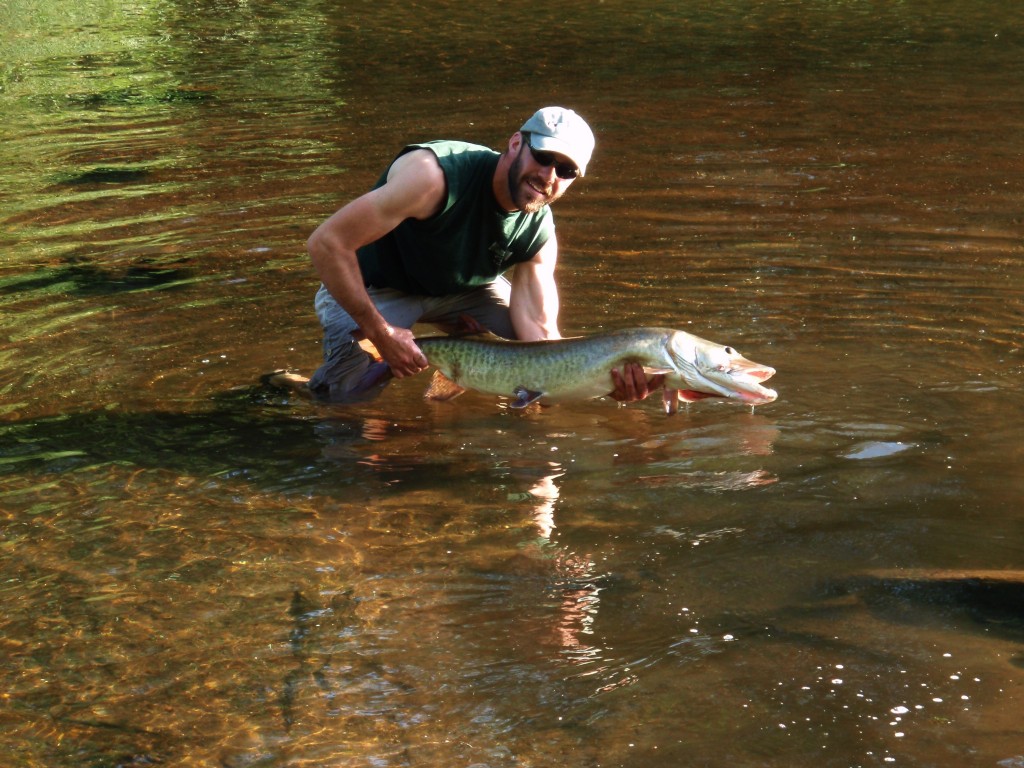
Landing and Handling
When fishing out of my jon boat, I just bring my standard huge musky net. It takes up a lot of room but it is worth it. If I am going to get out of my boat to fish or if I am fishing on foot period, I bring my Boga Grip model 130. The Boga is light and easy to carry and locks securely around the lower jaw of a musky. I tie a light rope to its handle so I can let the landed musky lie completely in the water while I get my release tools out and unhook the fish. It is the same principal as letting the musky sit in the water in the net bag during the same process. When releasing muskies, I try to find slack or at least slower water. If this is not an option, I never hold the musky with its nose pointing with the current, this can effectively drown the fish. If possible, I hold its nose into the current for a few seconds before letting it go. If this is not possible, I just make sure the fish is upright and let it go to drift with the current. This works just fine, especially if the fish hasn’t been played to exhaustion.
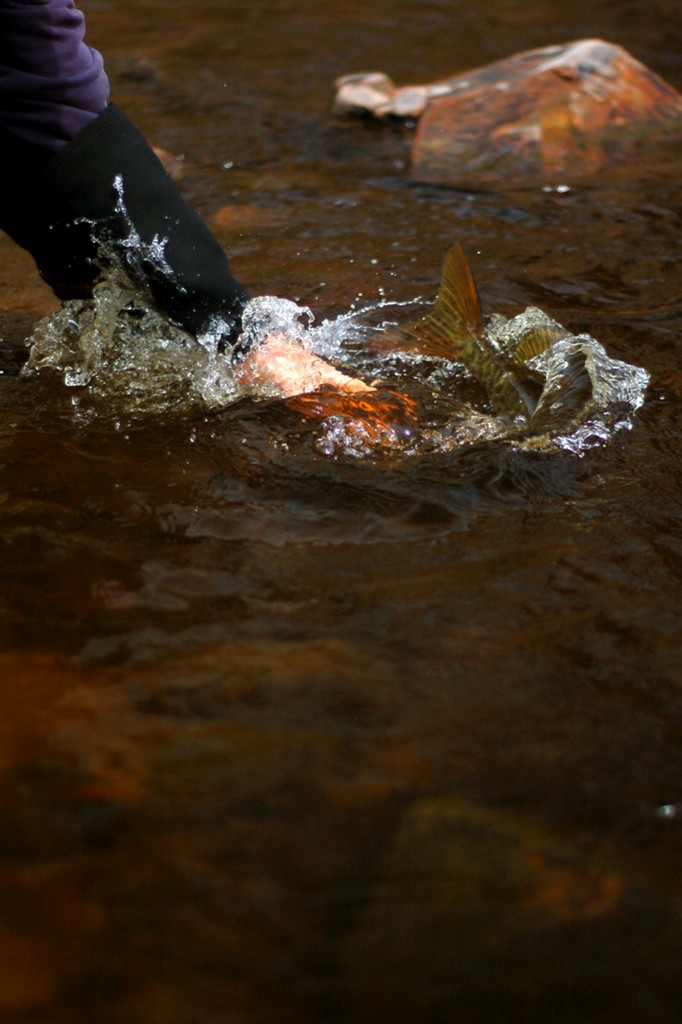
Conclusion
Whether a small river has had a musky population for thousands of years or just five years, chances are it does not get a whole lot of fishing pressure. This lack of attention however is not due to lack of potential. Adding small rivers to my repertoire of waters has greatly increased my seasonal productivity and overall musky fishing enjoyment. Anybody can experience the same if they pay close attention to the finer points of stream musky fishing.
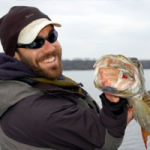 Adam M. Glickman
Adam M. Glickman
Adam Glickman, 33, originally from Ashland Wisconsin but now of the Minnesota Metro area, is field editor with Muskie Magazine, and a frequent contributor to Fishing-Headquarters and the online magazine. In 2014, Glickman began producing his new fishing program: Honest Musky Television is a unique, educational and entertaining fishing show. Our techniques are diverse, versatile, and often cost effective. We always get the strike and hookset on film, and in true honest musky fashion we use no fake hook sets or editing tricks. Glickman and his team films on a vast variety of aquatic environments from the smallest streams to the largest lakes, and done exclusively on public water, mostly in the Upper Midwest at affordable and realistic destinations.


